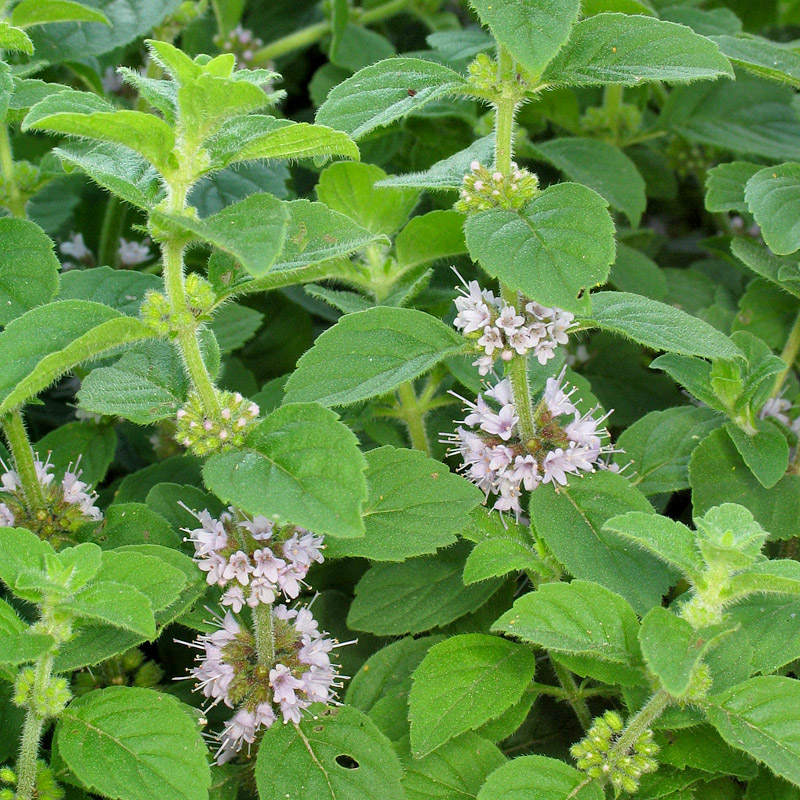Botanical name
(Japanese) Mint - Mentha arvensis var. piperascens Malinv. ex Holmes
Family
Labiatae (Lamiaceae)
Common name
Field mint, Chinese or Japanese mint
Information about the plant
The field mint is widespread in Europe and Asia up to Siberia and China, it is farmed mainly in Japan and China (Chinese or Japanese mint), but also in Brazil and India. When the leaves are rubbed they release a strong aroma of menthol, they are therefore confusingly similar to the peppermint. The perennial mint grows up to 60cm high, its leaves are elliptic-lanceolate to broadly ovate with a slightly serrated edge. The purple flowers are in dense pseudo whorls with 8 to 12 flowers on small bracts. Flowering time is June to August. An essential oil is obtained from the flowering herb by steam distillation, which contains about 80%(-) menthol. This is removed by cooling the oil into the crystal form. The menthol crystals are skimmed off and further purified and sold as natural (-)menthol. The oily residue is then rectified (fractionally distilled) and is traded as "mint" (menthol content 30 to 50%). Because it is cheaper than peppermint oil, it is very often used for the falsification of peppermint oil. In effect, the two oils differ little, the peppermint oil has a finer scent. Mint oil is also known as "Japanese herbal oil".
Medicinally used parts of plants (herbal drug)
The plant itself is not used medicinally, only partially released essential oil ("mint") from the menthol that comes from the flowering herb. The commercially available oil comes from Japan, China, India and Brazil.
Constituents of the herbal drug
Mint oil is made up of 30 to 50% (-)-menthol, and it also contains 15 to 30% menthone, menthyl acetate and 1-5% other terpenes.
Quality of the drug
The quality of mint (Mentha arvensis aetheroleum partim mentholum depletum) is specified in the European Pharmacopoeia (Ph. Eur).
Medical applications
Recognised medical use
Internally for functional gastro-intestinal discomfort associated with bloating, also for bile complaints and catarrh of the respiratory tract; externally as an inhalant for catarrh of the respiratory tract, as a rub for muscular pain of unknown causes and for nerve pain (Commission E).
Traditional use
No listing as traditional medical use (§ 109a).
Herbal drug preparations in finished dosage forms
Mint oil undiluted or in semisolid or oily preparations with 5 to 20% essential oil.
Dosage
Prepared drugs: see package insert;
Internally: take 1 or 2 drops of mint oil on sugar or in water1 to 2 times daily, daily dose is 3 to 6 drops. Externally: for inhalation add 3 to 4 drops of mint oil to hot water and inhale.
Notes
For internal use: Do not use mint for gallstones, occlusion of bile ducts, gall bladder and liver damage. External use: Do not apply mint oil directly onto mucous membranes or damaged skin, and never in the eyes.
For infants and toddlers up to 2 years old there is a risk of spasms or respiratory arrest, so do not apply on the face. As a precautionary measure it not recommended for use with children under 4 years old.
Side effects
When applied externally, sometimes skin irritations and eczema, internally stomach complaints can occur in people with sensitive stomachs.
Interactions
None known
References
Herbal drug monographs
Further literature
Schilcher: Leitfaden Phytotherapie, pg. 182
Van Wyk: Handbuch der Arzneipflanzen, pg. 205
Kommentar zum Europäischen Arzneibuch (Mint oil, no. 1838)


